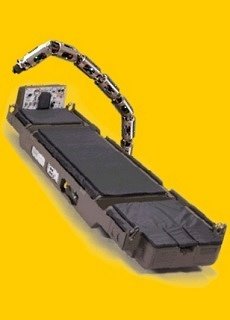
An increasing use of medical robotics is in the battlefield where medical robots are used to treat soldiers who are wounded in the frontline. One example of such robots is the Life Support for Trauma and Transport (LSTAT) /Snake Robot.
The LSTAT is a portable surgical platform (stretcher) which integrates various state-of-the–art medical devices. LSTAT incorporates many functions of the Intensive Care Unit (ICU) such as a defibrillator, providing oxygen supply, analyzing blood, suction and physiological monitoring. These high-tech stretchers are currently being used by the US Army in Iraq and
Afghanistan. To further enhance the capability of the LSTAT, Carnegie Mellon University is working with the US Army’s Medical Research Department to integrate a snake robot with the LSTAT. This snake robot is capable of diagnosing and treating wounded soldiers on the spot, hence minimizing battlefield casualties as most fatalities occur due to late treatment being given. The snake robot is basically a serpentine arm(s) (think Doc Oc in Spiderman) which is capable of performing various medical functions such as:
- serving as a third hand for the medic
- moving an ultrasound probe under the control of a remote physician
- spraying antiseptics and antibiotics onto wounds
 At present, Carnegie Mellon researchers have integrated built-in cameras onto the snake robot which allow for the inspection of a patient by remote physicians. The cameras which are mounted onto serpentine arms are preferred over the conventional method because it requires less sweep volume. Telemedicine (remote surgery) requires a dedicated connection bandwidth in order to minimize data lagging, which may affect the co-ordination between the doctor and the robot, hence affecting the patient. This has been resolved as LSTAT’s hardware capability is more than sufficient to handle the bandwidth issue.
At present, Carnegie Mellon researchers have integrated built-in cameras onto the snake robot which allow for the inspection of a patient by remote physicians. The cameras which are mounted onto serpentine arms are preferred over the conventional method because it requires less sweep volume. Telemedicine (remote surgery) requires a dedicated connection bandwidth in order to minimize data lagging, which may affect the co-ordination between the doctor and the robot, hence affecting the patient. This has been resolved as LSTAT’s hardware capability is more than sufficient to handle the bandwidth issue. How are military medical robots like in Singapore? Last checked, they are relatively underdeveloped compared to the US. The various collaborations made between DSO, the local universities and the Singapore Armed Forces rarely involve medical robots. The potential of the snake robot is tremendous as it is potentially able to perform many medical functions. The US Army has provided research grants to various universities for further development of the snake robot. Perhaps one day, it will be able to perform surgery right on the spot, with minimal assistance from a remote doctor or medic.
References:
1. LSTAT/Snake robot video
2. LSTAT/Snake robot description
3. TATRC Cutting Edge Medical Technology
4. Study of LSTAT integration to Robotics
Blog entry posted by
Ng Chin Ling U047690E

